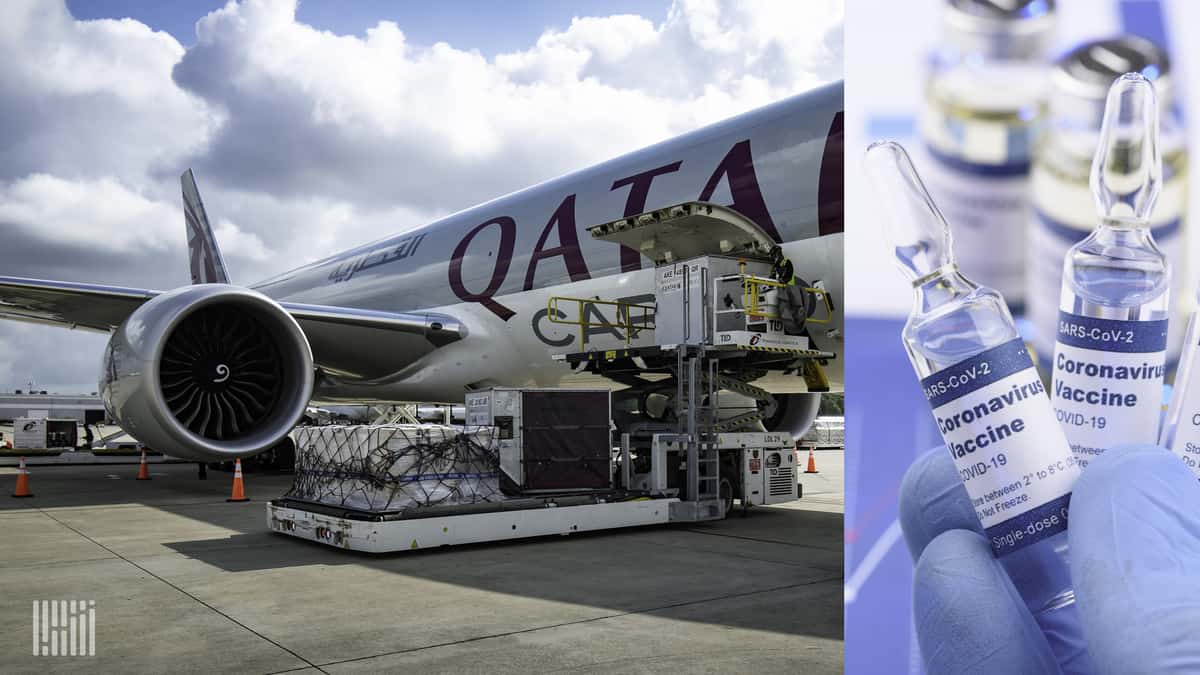Logistics industry preparation to assist with the global distribution of COVID-19 vaccines is largely built on educated guesses because of an information hole about precise shipping requirements for each drug and who has the necessary cold storage and transportation capacity. The International Air Transport Association and the Cool Chain Association this week released tools and guidance to help remove that cloud of uncertainty and foster end-to-end collaboration across the supply chain.
The resources come none too soon. D-Day for distributing the first COVID-19 vaccine could occur as soon as next month after Pfizer said Wednesday that it has completed Phase 3 clinical trials with a 95% efficacy rate and plans to apply within days to the Food and Drug Administration for an emergency use authorization. Pfizer’s two-dose vaccine will be shipped in specially designed, thermal boxes utilizing dry ice to maintain temperature conditions of minus 70 degrees Celsius (minus 94 Fahrenheit).
Many logistics providers won’t have the ultracold storage capabilities to handle the Pfizer product, but other vaccines in the pipeline are less temperature sensitive.
The primary issue facing the airfreight sector is how to scale up and adapt existing infrastructure, processes and resources that comfortably support routine vaccine programs for an expected surge of emergency shipments to immunize 7.8 billion people worldwide. Industry representatives say timely and accurate sharing of information, as well as multilateral partnerships among pharmaceutical companies, logistics providers, governments and humanitarian organizations are necessary to ensure deliveries get to administration points quickly without spoilage.
Critical information for vaccine logistics includes where and how vaccines will be manufactured, the origin and destination for transportation, under which conditions they must be handled, and how they will be secured.
The International Air Transport Association, which has established an information-sharing forum to help prepare for a vaccine rollout, on Monday issued guidelines for overcoming logistics risks associated with product safety, verifying partner capabilities, operations, infrastructure, adequate trained workforce, border clearance, communications and data connectivity, and security.
The trade group recommends governments take into consideration that the air transport system is operating at three-quarters of normal capacity because airlines sharply downsized and parked aircraft in response to the plunge in passenger traffic associated with coronavirus.
“In planning their vaccine programs, particularly in the developing world, governments must take very careful consideration of the limited air cargo capacity that is currently available. If borders remain closed, travel curtailed, fleets grounded and employees furloughed, the capacity to deliver life-saving vaccines will be very much compromised, including the last mile,” the IATA document says. “[Global health and aid organizations] have already reported severe difficulties in maintaining their planned vaccine programs during the COVID-19 crisis due, in part, to limited air connectivity. Therefore, accessing capacity will be achieved only through cautious planning.”
IATA urged governments to temporarily grant additional traffic rights to air carriers for operations carrying COVID-19 vaccines, where restrictions may apply.
Cool Chain Association airport matrix
Meanwhile, the Netherlands-based Cool Chain Association has produced a matrix to benchmark the ability of airports to safely and efficiently handle COVID-19 vaccines and identify shortcomings.
Member companies will receive a survey to complete to document their capabilities on adhering to temperature requirements, packaging, forecasts for anticipated volumes, and time frames for vaccines to move through different stages of airport processing.
The consolidated information will be used to help supply chain stakeholders address potential bottlenecks, training needs, safety and security, and quality control. The matrix includes sections on forwarding facilities, airport warehouses and ramp operations.
The tool appears to resemble IATA’s One Source tool for evaluating the cold-handling capabilities of aviation logistics parties and facilities.
Last month, the two organizations joined forces to develop common work programs, including temporary task forces and round tables, and share feedback, experiences, knowledge and best practices regarding transport of perishable and pharmaceutical products.
Click here for more FreightWaves/American Shipper stories by Eric Kulisch.
RELATED NEWS:
Will we really need 8,000 jumbo jets to transport COVID vaccines?
COVID vaccine fallout: General cargo, wait your turn
Supply chains will face multiple scenarios for shipping COVID vaccines
Information fog hinders air cargo readiness for COVID vaccine











